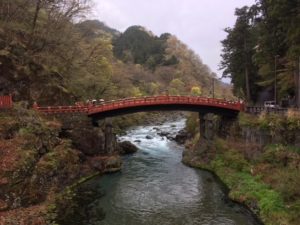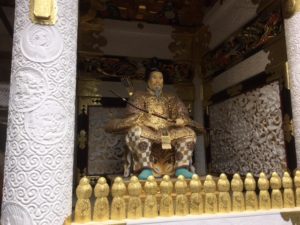
Nikko’s arched Shinkyo Bridge spans the Daiya River.
Last in a Series. Nikko, Japan, is just 72 miles (120 km) and two hours north of Tokyo by train, but seems a world apart.
Situated at an elevation of more than 4,200 feet (about 1,300 meters) and sporting crisp, clean mountain air, Nikko’s central area reminded us of an alpine village, including some chalet-style architecture and a roadside stand dispensing crêpes.
A mountain river tumbles through a gorge and forests fill the mountains. Hot springs, hiking trails, lakes, and waterfalls grace Nikko National Park, which borders the city of 85,000. And UNESCO World Heritage Sites are within walking distance of Nikko’s central square.
Nikko National Park and a World Heritage Shrine
While Nikko is an extremely popular day trip from Tokyo, we stayed overnight and are glad we did. It gave us time to absorb the atmosphere and explore Nikko’s main claim to fame, Toshogu, known as one of Japan’s largest and most lavishly decorated Shinto shrines.
Situated amid cedar trees at the entrance to Nikko National Park, Toshogu is a vast complex that includes the mausoleum of Tokugawa Ieyasu, who founded the Tokugawa shogunate (known as the Edo period) that ruled Japan for more than 250 years until 1868.
Special buses run up to Toshogu from the central square, but we chose to walk and get breakfast along the way — it’s about a mile or two stroll with a gentle up-slope. You’ll know you’re there when you reach the Daiya River and spot the arched Shinkyo (“sacred”) bridge, which crosses the river a short distance from the main road.
The bridge is considered one of the most beautiful in Japan, and the setting reminded me of Switzerland.
Across the road lay the national park entrance, with a number of steps leading up a hillside in different directions. There were no signs reading “This way to Toshogu,” so we followed what seemed to be the most well-trod path, which led past a parcel of upscale homes and eventually to a surprising number of fellow visitors climbing the wide steps up to the shrine.

Golden statuary at Toshogu shrine, Nikko, Japan.
By the time we arrived within sight of the main entrance gate, at perhaps 10 a.m. on a Sunday morning, the once-sparsely populated path had turned into a torrent of humanity — where had they all come from?
Nikko, understandably, is a favorite weekend getaway for Tokyo residents, and Toshogu is Nikko’s number one attraction. Maybe we ate and ambled too much along the way there.
Exploring Toshogu
Toshogu is one of those places where you might as well put your guidebook down and surrender to its sheer size and, well, awesomeness.
The awesomeness begins at the ornate Yomeimon Gate that leads into the main complex, and continues past a series of richly ornamented shrines that display both Shinto and Buddhist elements. (Toshogu is now strictly Shinto — the two religions once mingled — but the Buddhist elements play such an integral role in the design that they were allowed to remain.)
Everywhere you turn, you see soaring pagodas, tons of brilliant gold leaf, colorful paintings, and clever wood carvings. Even the storehouses feature elaborate carvings, including one of the “hear no evil, speak no evil, see no evil” monkeys.
To tour the main shrine building, we took off our shoes and followed the crowds past steely-eyed watchful priests, who made sure no one took surreptitious photos. After retrieving our shoes, we were crushed by crowds — now with smartphones and cameras back in hand — photographing a famous carving of a sleeping cat while we tried to squeeze through a narrow gate (proof that a cat can sleep through anything).
The gate led up a hill to the secluded wooded tomb of Tokugawa Ieyasu, the shogunate ruler who died just over four centuries ago but continues to live in selfies across Japan and the world.
It seemed a fitting time to depart the remarkable complex engineered by his grandson back in the early 1600s, as we followed paths back down through the forest and into town.
My takeaway from Toshogu is by all means go — but preferably get there right when it opens on a weekday not in cherry blossom season.
We were certainly sorry to leave Nikko — a taste of the rural Japan away from the big cities, alluring as they are. But every trip must eventually end, or so I’m told, and we left Japan with memories of Nikko as refreshing as its mountain air.
Practical Details
You have a choice of a number of different trains from Tokyo to Nikko, most in the range of two hours’ duration but a few a bit slower; most require one transfer.
We took the JR Shinkansen bullet train so we could use our Japan Rail Pass, but if you don’t have a rail pass you can take the popular Tobu Railway, which leaves from Tokyo’s Tobu Asakusa Station. JR and Tobu trains arrive at separate stations in Nikko, but are located very near each other on the central square.
We stayed at the friendly and well-appointed Hotel Nikko Station, especially welcome since it sits just across the square from the train stations. The hotel features Western-style beds and bath, a restaurant, and an indoor public bath.
Note that renovations have been in progress at Toshogu since 2007 and will be completed in 2020, so one or two of the complex’s dozen structures may be covered by scaffolding until then.
Photos by Catharine Norton










Leave a Reply